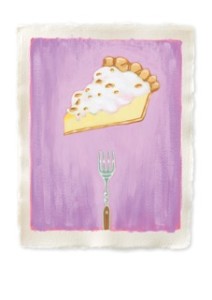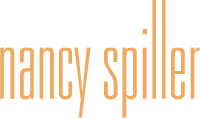October 24, 2013
 My mother is by my side as I roll out a piecrust in my southern California kitchen, instructing me with an authority and enthusiasm she rarely displayed in her life. I don’t make piecrust often, but when I do she is always there, at least in my imagination.
My mother is by my side as I roll out a piecrust in my southern California kitchen, instructing me with an authority and enthusiasm she rarely displayed in her life. I don’t make piecrust often, but when I do she is always there, at least in my imagination.
In my mind we are in her kitchen, the kitchen of my childhood home, her workplace. I am nine years old. The San Francisco East Bay light is bright white, but not harsh like Southern California light can be. The linoleum floor is clean, the coved tile counters recently wiped down to a satin sheen with her damp kitchen rag. My mother’s hands are plump, less spotted with age than mine are now, her bosom ample, though slumped with middle age. Her coloring is vivid, considering she smokes, doesn’t exercise, or wear makeup.
We roll out the crust as round and thin as we dare, and she lifts it delicately from the floured surface to the waiting metal pan, a trip fraught with tension until the safe landing. We exhale in tandem before she allows me the well-earned pleasure of crimping the crust’s edge with finger pressed to thumb for a perfect ruffled selvage.
The preheated oven welcomes our pie shell into its gas-warmed belly for the first bake-to-brown step.
Our concern now turns to the filling. If we are making lemon meringue it’s a double boiler stove-top operation. I am only nine, but I know well the pleasures of a perfectly baked, weeping golden mound of meringue. Today, though, we’re going a different route, a cooler direction. We’re making my mother’s Lemon Chiffon Pie.
The word chiffon always stops me, makes me think of gauzy fabric, the gathered skirts of ball gowns. Chiffon is not my favorite word for things to be eaten.
I try not to think of the name when I do eat it, the cool gelatinous filling of egg and lemon and sugar topped with whipped cream and chopped walnuts, set in a flaked Crisco crust with a delectable grain of salt. It’s like biting into a sweet lemon swamp topped by a bank of cream fog; a scattering of walnuts offers the only resistance. These walnuts were grown on our backyard tree, shelled on our hearth, and chopped in a wooden bowl with a wooden handled, crescent moon shaped rocker blade.
But this was in the 1960s in Northern California, when my mother was still alive.
She is now four years gone, and I am making that same pie from the card I found in her recipe box. The card names it Sunny Silver Pie. Maybe my mother changed the name to reflect her need for a less pathetically optimistic sounding pie: a sunbonnet-wearing covered-wagon pioneer of a pie. Or maybe she changed the name to recapture a lost sense of genteel style, to express a longing for more luxurious fabrics than the cotton she sewed by machine orsometimes even, with lumpy results, by hand. Perhaps she wished to experience chiffon as a pie since she no longer had any occasion to wear it.
I now live in Southern California, on the far western edge of Los Angeles, known as The Big Wild. The light and the meteorological effects of the ocean air on the land are closer to those of my Northern California sensibility than what I experienced all the years I lived farther inland. Here, mist melts over the mountain ridge that separates us from the ocean. The bright Mediterranean light bounces off the saturated colors of our coastal canyon.
My visit with my mother, her life, and our times together, comes by way of her recipe box that now sits on my kitchen counter. I rescued the yellow box, ancient rust marring the rolled edges of its lid, hand-painted flowers still exuberant after decades despite petals scratched away, from the pile of her possessions headed to landfill when we cleaned out her house, my childhood home, after she’d been moved to a small residential care facility in early 2002. It wasn’t until months after her death in December of 2007 that I spent any time exploring it.
It was a bite of a walnut from the Santa Monica farmers’ market that compelled me to make this Sunny Silver Pie. The Central Coast–grown, freshly harvested nuts taste more like the nuts of our backyard tree than any I’ve had since my childhood. I’m sure it is their freshness combined with the soft coastal air and the winter light, but they conjured a quick and visceral longing for that pie.
The recipe’s directions end with “top with whipped cream and nuts, if you desire.”
If you desire.
It’s the whipped cream and nuts that I desire most at this moment.
But the phrase stops me.
If you desire.
It’s timid, wistful, and indifferent all at once. I can’t help but wonder what, beyond whipped cream and nuts, my mother desired. And I wonder to what degree I desire the same things.
We didn’t have many satisfying “mother-daughter” talks when she was alive. I usually felt I was the mother, lashed with the need to understand a withdrawn, recalcitrant, unhappy daughter. My job, like that of any concerned parent, was to try to figure out what my coy, puzzling, enigmatic, fey, angry, teasing, infuriating daughter meant in any given moment. My hope was to help her become the palpable parent, available and appropriately concerned about my childish needs.
But that wasn’t meant to be.
The recurring conversations I best recall from living together were her efforts at determining what I might desire, if only to eat. It began with her poking her head inside the door of the TV room and asking playfully if I’d like anything from the kitchen. I would say, “What did you have in mind?” and she would respond with tempting items like apple pie à la mode, or chocolate cake or oatmeal cookies. When I finally said yes to the cake or the pie or the cookies, she’d say with a mischievous grin, “Well, we haven’t any.”
Our best conversations took place in the kitchen where I wasn’t the child, but instead an eager student of her culinary secrets that enhanced our otherwise unappetizing lives. I continue these conversations with my mother through her recipe box. It is part Ouija board, part crystal ball, part interactive text. Here my mother is again my mentor. As student, I will make the recipes and remember our life together.
Splashing about in the flour, sugar, and shortening of my childhood feels like a threat to my adult health. But it was finding the recipe for Sunny Silver Pie, and the Oven Baked Spareribs recipe that forever spoiled me for anyone else’s ribs, and an ancient, crumbling card for the sugar cookies I devoured far too many of as a child, that compelled me to embark on this culinary journey. The cookie recipe was signed by my Grandmother Soult, my mother’s mother, who died the year before I was born. There were also recipes I wasn’t familiar with but immediately intrigued by: Compromise Cake and My Man Cookies, both of which I suspect were given to my mother right around her wedding in the early 1940s.This recipe box is not only a portal into my mother, but one into the ancestors I knew little about—my mother was incapable of providing reliable details—and a window to mid–twentieth century marriages.
Then, toward the very back of the box, I found a folded over and clipped paper sealing my fate. At first I thought it was a recipe clipping or an old receipt, like the one from a fabric store from the 1940s that I had discovered earlier. I removed the clip; it was white, no signs of rust, it could have been from the seventies or from yesterday. I gasped when I unfolded the paper and realized what I held in my hand. It was my mother’s teaching credential, received from San Francisco State University, May 24, 1940 (dated at Sacramento), a general elementary school credential.
If you desire.
Did my mother desire to be a teacher? Her Aunt Maude in Kansas, her father’s older sister, had been one. Teaching was one of the few professions open to women, be it to support themselves independently or maintain the balance of power in a marriage. My mother had gone to college and earned a credential licensing her to teach in the State of California. I knew that she had taught only one year: from September 1940 to June 1941, in a one-room schoolhouse in Tulelake, a rural community in the far northeast corner of California. It was only a few years after Dorothea Lange took iconic photos of its dust bowl refugees. Maybe my mother taught some of the children of those emigrant families.

Beautiful, evocative work, Nancy! Thank you.